Lunar Mass Drivers: Moon Catapults for the Space Economy
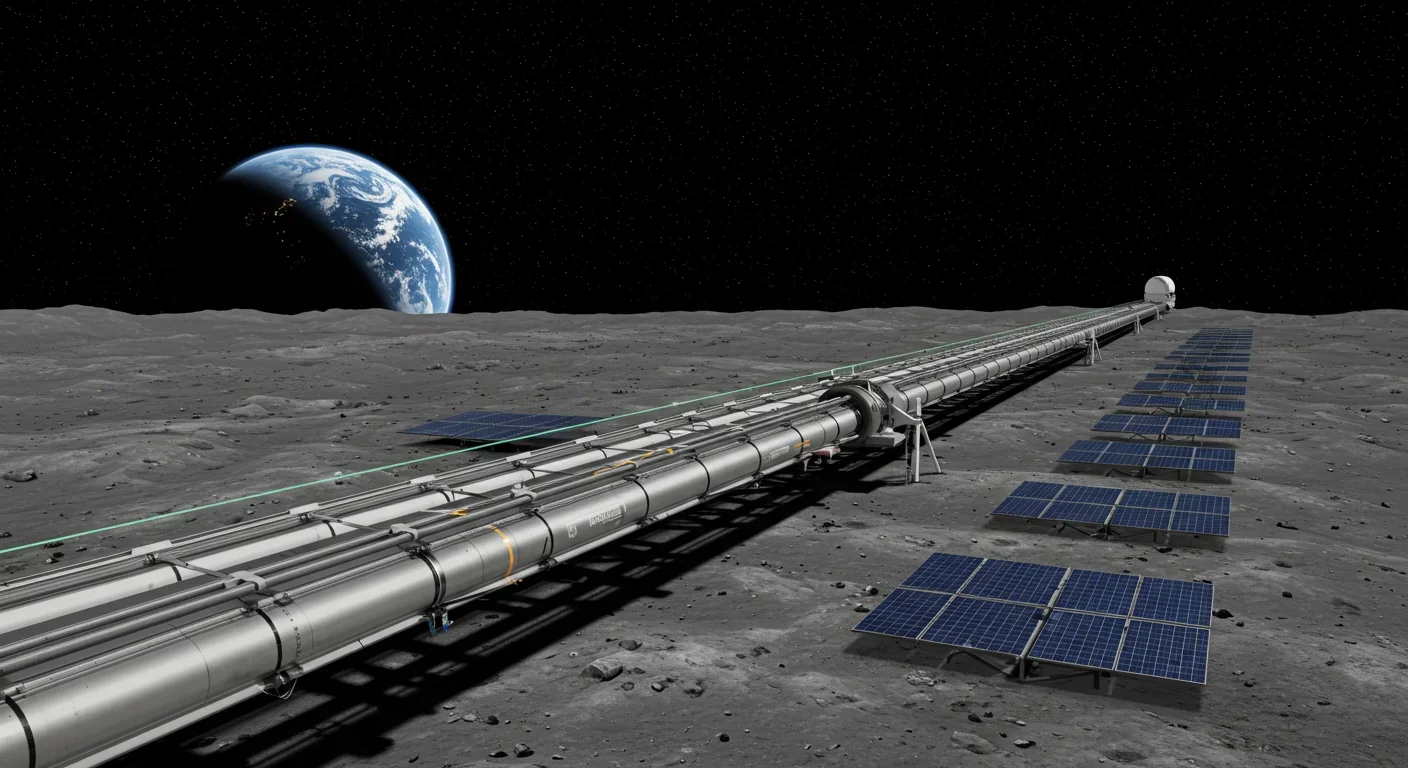
TL;DR: Pluto's Sputnik Planitia features nitrogen ice glaciers actively churning at -230°C, 3.7 billion miles from the Sun. Convection cells refresh the surface every 500,000 years, powered by internal heat from either radioactive decay or a subsurface ocean, proving small distant worlds can remain geologically active for billions of years.
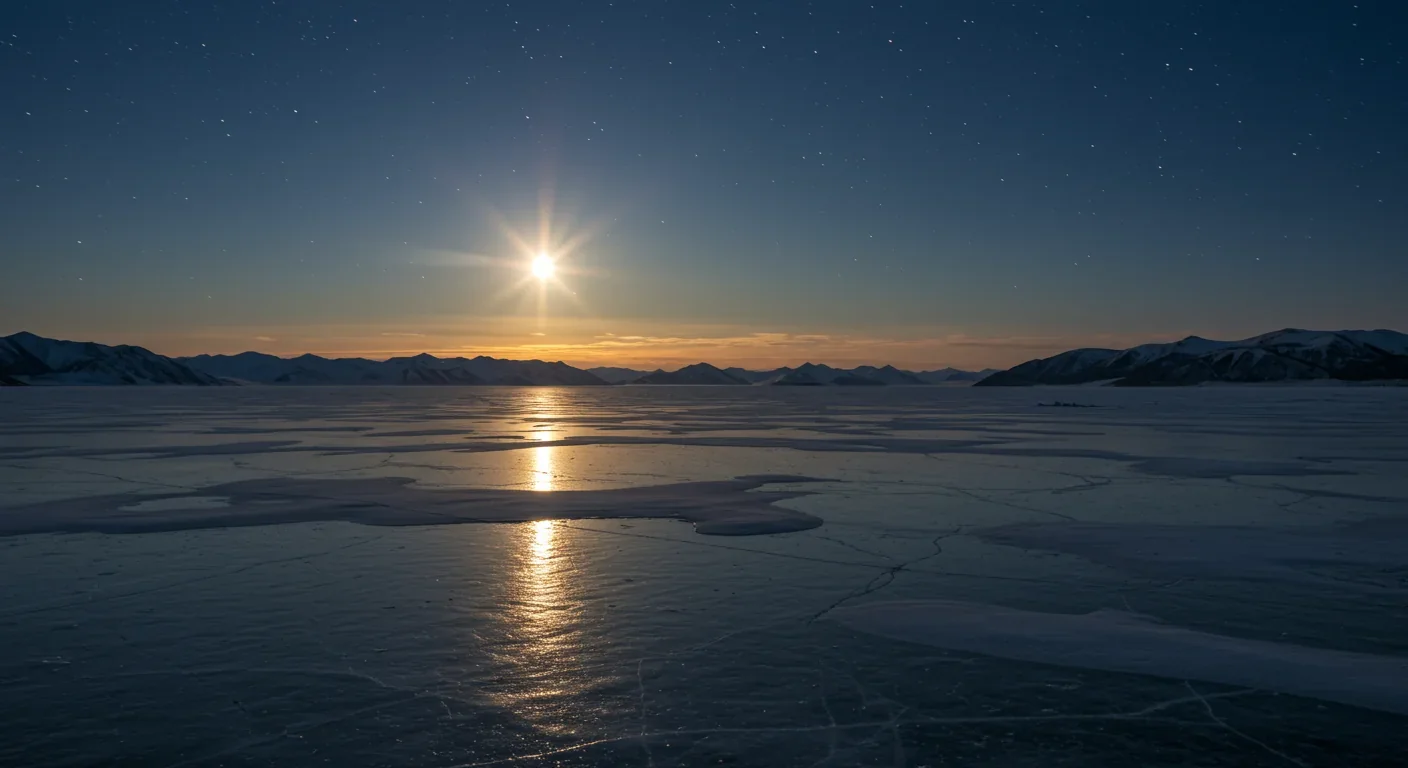
When NASA's New Horizons spacecraft screamed past Pluto at 30,000 miles per hour in July 2015, scientists expected to find a frozen corpse of a planet. Instead, they discovered something that shouldn't exist: vast plains of nitrogen ice glaciers churning like a cosmic lava lamp at temperatures that would freeze carbon dioxide solid. At -230°C (-382°F), 3.7 billion miles from the Sun, Pluto is doing something impossible. It's alive.
This discovery forces a fundamental rethink of what drives geological activity across the solar system. For decades, planetary scientists assumed small worlds cool fast, large worlds stay active longer. Pluto, one-sixth the mass of Earth's Moon, should have frozen solid eons ago. Yet Sputnik Planitia, the western lobe of Pluto's famous heart-shaped region, shows convection cells actively turning over every 500,000 years. If Pluto can maintain active geology at the outer edge of the solar system, what else are we wrong about?
When New Horizons returned its first high-resolution images, the science team couldn't believe what they were seeing. Instead of the crater-pocked wasteland everyone predicted, Pluto's surface was astonishingly diverse. Mountain ranges of water ice as tall as the Rockies. Nitrogen glaciers flowing like honey. And a vast smooth plain completely devoid of impact craters.
That last detail was the kicker. Crater counting is planetary geology's clock. Count the craters, calculate the surface age. Pluto orbits through the Kuiper Belt, a shooting gallery of icy debris. It should be covered in craters.
Sputnik Planitia has none. This surface must be less than 10 million years old, possibly much younger. Something is constantly erasing the craters, refreshing the surface with new material from below. On a world that receives 1/1600th the sunlight Earth does, where temperatures hover 40 degrees above absolute zero, active geology shouldn't be possible.
Sputnik Planitia's surface shows zero detectable impact craters, indicating that active processes have completely refreshed this Texas-sized region within the last 10 million years—a geological eyeblink for a world 4.5 billion years old.
The research team at UC Santa Cruz discovered that Sputnik Planitia sits in a massive impact basin 1,000 kilometers across and 4 kilometers deep. Over millions of years, this basin became a "cold trap" where nitrogen ice preferentially accumulated. Think of it as a planetary-scale version of how frost collects in shady hollows on a winter morning. Except this hollow is the size of Texas, and the frost is kilometers deep.
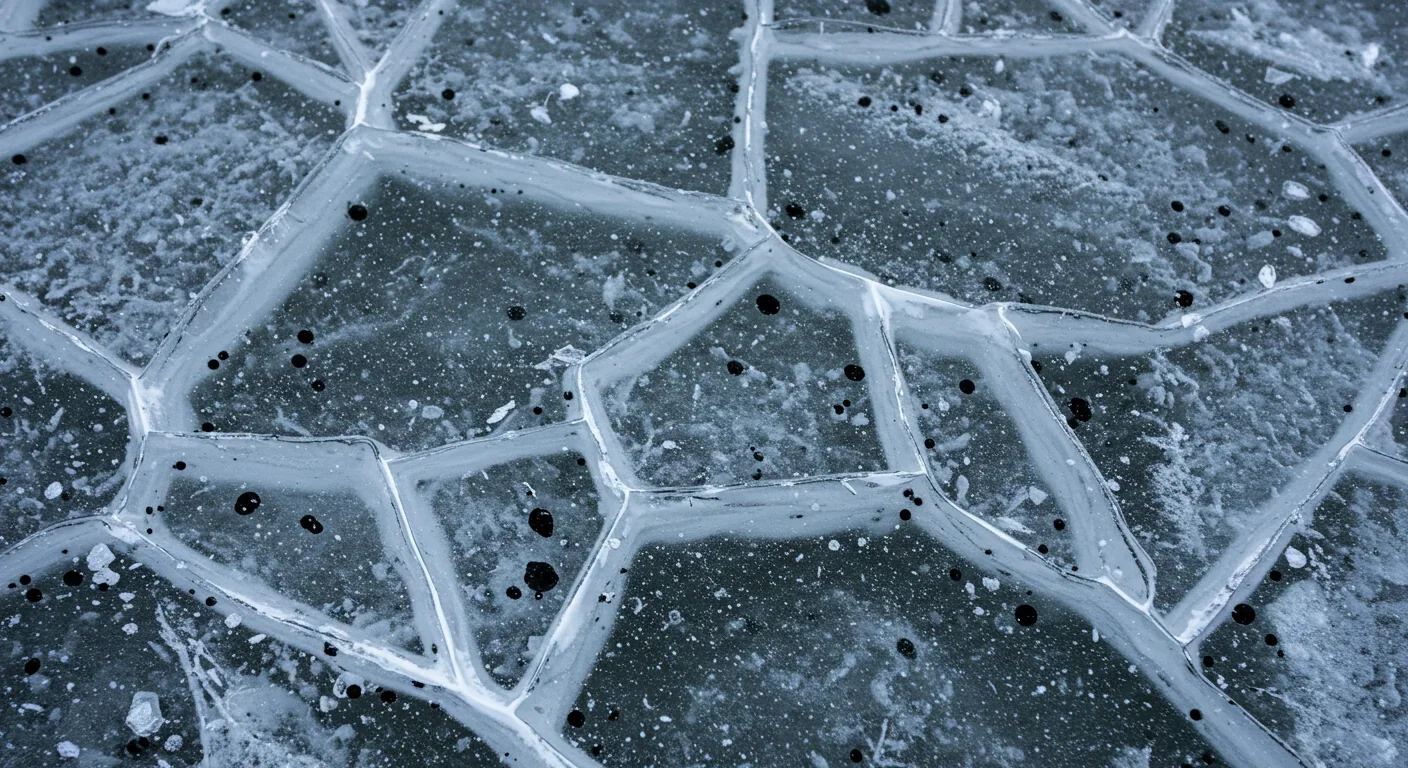
At Earth's room temperature, nitrogen is a gas. Cool it to -210°C and it becomes liquid. Drop the temperature to -230°C and nitrogen freezes solid. But "solid" doesn't mean immobile.
Solid nitrogen has bizarre properties. Unlike water ice, which is relatively rigid, nitrogen ice becomes ductile and mobile at temperatures far below its freezing point. The technical term is "solid-state convection"—the material is frozen, but viscous enough to flow on geological timescales.
Pluto's nitrogen ice sheet, estimated at 3-4 kilometers thick, sits atop a crust of much more rigid water ice. Water ice at -230°C is as hard as granite. This creates perfect conditions for convection: a thick layer of relatively mobile material floating on a rigid substrate. Heat rising from Pluto's interior warms the base of the nitrogen layer, causing warmer, less dense ice to rise while cooler, denser ice sinks.
The result? Polygonal convection cells visible from space, each averaging 33 kilometers across. Computer modeling suggests the ice flows at about 7 centimeters per year, completing one full overturn cycle every 500,000 years. For comparison, Earth's mantle convects at roughly the same rate, but Earth has 318 times Pluto's mass and sits 40 times closer to the Sun.
The cells have distinct anatomy. Fresh ice rises at the centers, spreads outward, cools at the surface, and sinks at the margins. Floating at these margins are kilometer-sized chunks of Pluto's water ice crust—icebergs drifting on a frozen sea, carried by glacial currents.
"Pluto is one of the most contrastive bodies in the Solar System, with geology every bit as complex as that of Mars."
— Jeff Moore, New Horizons Geology Team
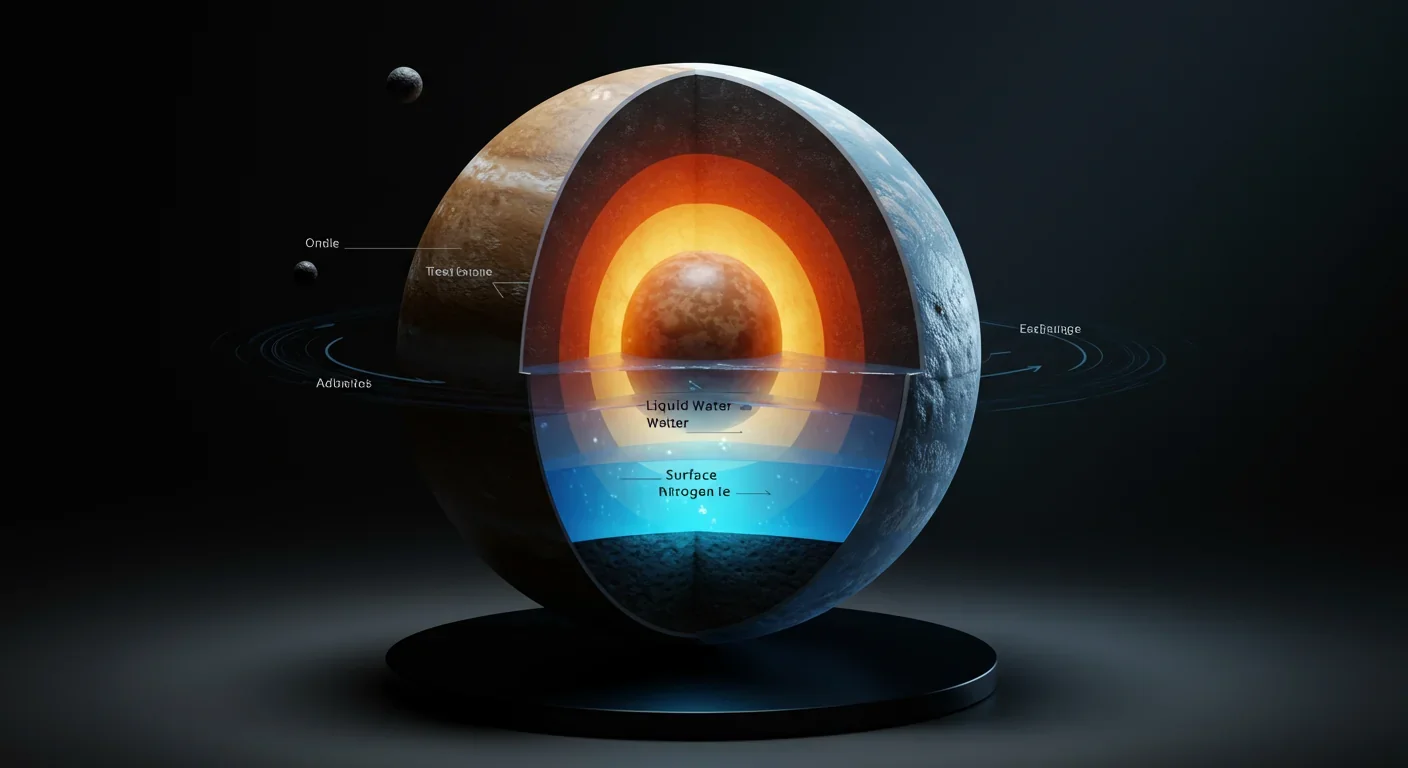
Active convection requires energy. So where's Pluto getting it? The obvious answer—sunlight—doesn't work. Pluto receives about 0.06% of the sunlight Earth does. The energy has to come from inside.
One possibility is radiogenic heating—the warmth produced by radioactive decay of uranium, thorium, and potassium in Pluto's rocky core. All planetary bodies have some radiogenic heating. For Earth-sized planets, it's a major heat source. For small bodies like Pluto, it was assumed to be negligible.
But maybe we underestimated how much radioactive material Pluto contains. Pluto's relatively high density suggests it's about 70% rock by mass, with a rocky core approximately 1,700 kilometers in diameter. That's more rock than many icy moons of the outer planets. More rock means more radioactive elements, means more heat.
The second possibility is even more intriguing: a subsurface ocean. Multiple lines of evidence suggest Pluto might harbor a layer of liquid water mixed with ammonia deep beneath its frozen crust. The gravity anomaly data from New Horizons supports this. Sputnik Planitia shows a positive gravity anomaly, as if there's extra mass beneath it. An ocean would be denser than ice, explaining the anomaly.
If Pluto has an ocean, it changes everything. Liquid water is an excellent thermal blanket, transporting heat from the core to the base of the ice shell far more efficiently than solid ice. The ocean would deliver radiogenic heat from deep inside to the underside of the nitrogen ice layer. That heat wouldn't escape quickly through kilometers of insulating ice and water, creating the temperature gradient necessary for sustained convection.
When Pluto coalesced from the Kuiper Belt's debris 4.5 billion years ago, the energy of impacts would have heated the interior. If the dwarf planet formed fast enough, it might have started hot, with a liquid interior that never completely froze. Ammonia mixed into the water would act as antifreeze, keeping the ocean liquid even at temperatures far below water's normal freezing point.
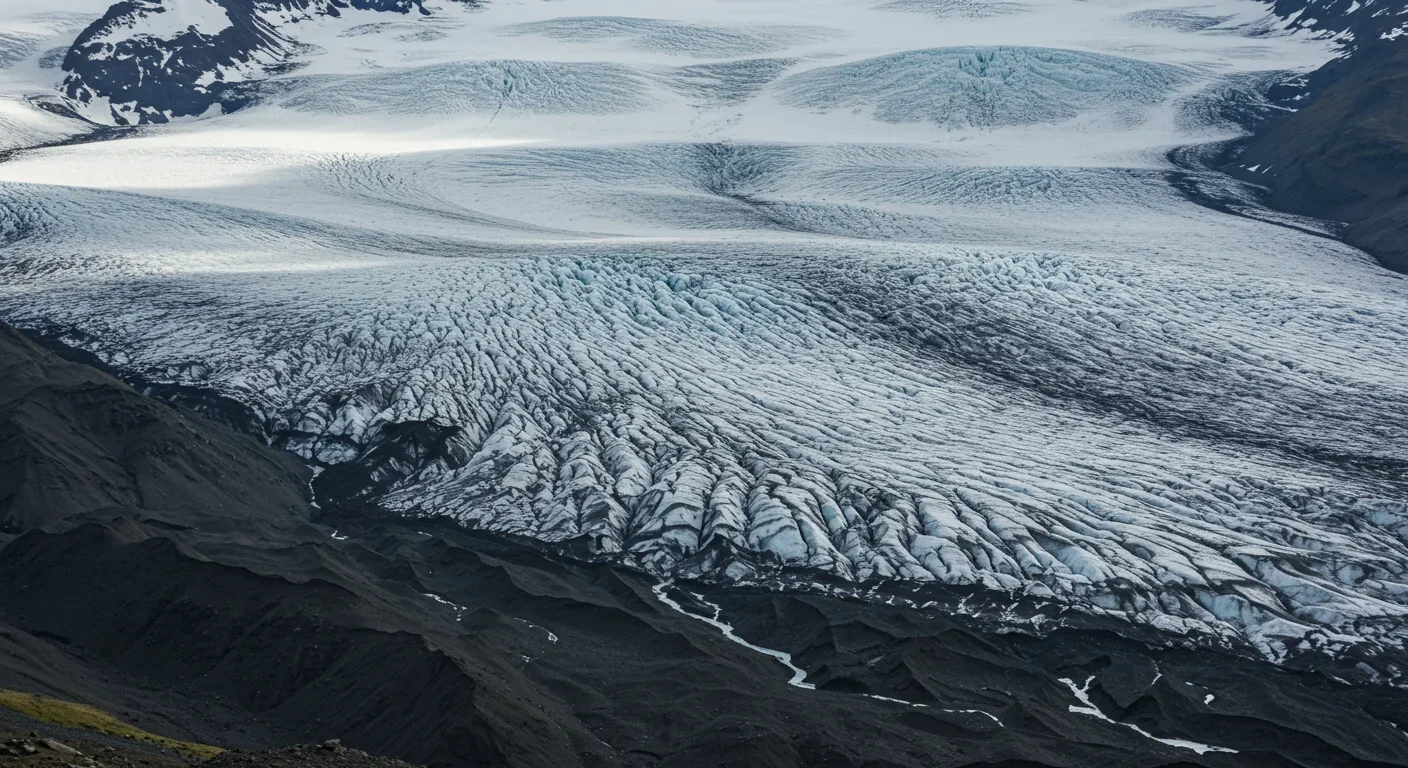
The surface features tell stories about the world beneath. Those smooth cell centers? They're where fresh ice, warmed from below, rises to the surface. The dark, elongated pits scattered across Sputnik Planitia? They're sublimation features—places where ice evaporates directly into Pluto's thin atmosphere without melting.
As the ice convects, these pits get carried from the cell centers toward the margins, growing larger as more ice sublimates. By mapping pit sizes and distributions, scientists can reconstruct the ice's journey. The pits are like drift bottles in the ocean, revealing current patterns.
Even more revealing are the glaciers flowing out of Sputnik Planitia into surrounding craters and valleys. These nitrogen ice rivers extend hundreds of kilometers beyond the main basin, filling topographic lows with frozen volatiles. Some show clear flow lines and ridges parallel to the flow direction. Others have pushed aside and even overridden obstacles in their path, demonstrating surprising force for material moving at centimeters per year.
The ice isn't pure nitrogen—it's a mixture of nitrogen, carbon monoxide, and methane ices, with nitrogen as the dominant component. These three ices have different volatilities and different viscosities. Sunlight heats the surface in Pluto's equatorial regions, preferentially evaporating the more volatile components. This creates chemical segregation within the convection cells.
Here's what makes Pluto's activity so revolutionary: every previous model of planetary evolution says this shouldn't happen. The textbook explanation: planets form hot from the energy of accretion. Small bodies cool rapidly because they have high surface-area-to-volume ratios. Within a few hundred million years, small worlds freeze solid, becoming geologically inert for the remaining life of the solar system.
Mars fits this model. It's much larger than Pluto—about nine times the mass—yet it went geologically dead billions of years ago. Pluto breaks every rule. It's tiny, distant, and 4.5 billion years old. By every measure, it should be dead.
Yet Jeff Moore from the New Horizons team described Pluto's geology as "every bit as complex as that of Mars." Mountain ranges. Glaciers. Possible cryovolcanoes. Ancient impact basins and recently resurfaced plains existing side by side.
Pluto's geological activity challenges the fundamental assumption that small, distant worlds must be geologically dead. If a dwarf planet at the edge of the solar system can remain active for 4.5 billion years, our models of planetary evolution need serious revision.
What does this mean for the thousands of other Kuiper Belt objects out there? For decades, we assumed they were all frozen, dead worlds. If Pluto can be active, maybe they can too. Maybe the outer solar system is far more geologically diverse than anyone imagined.
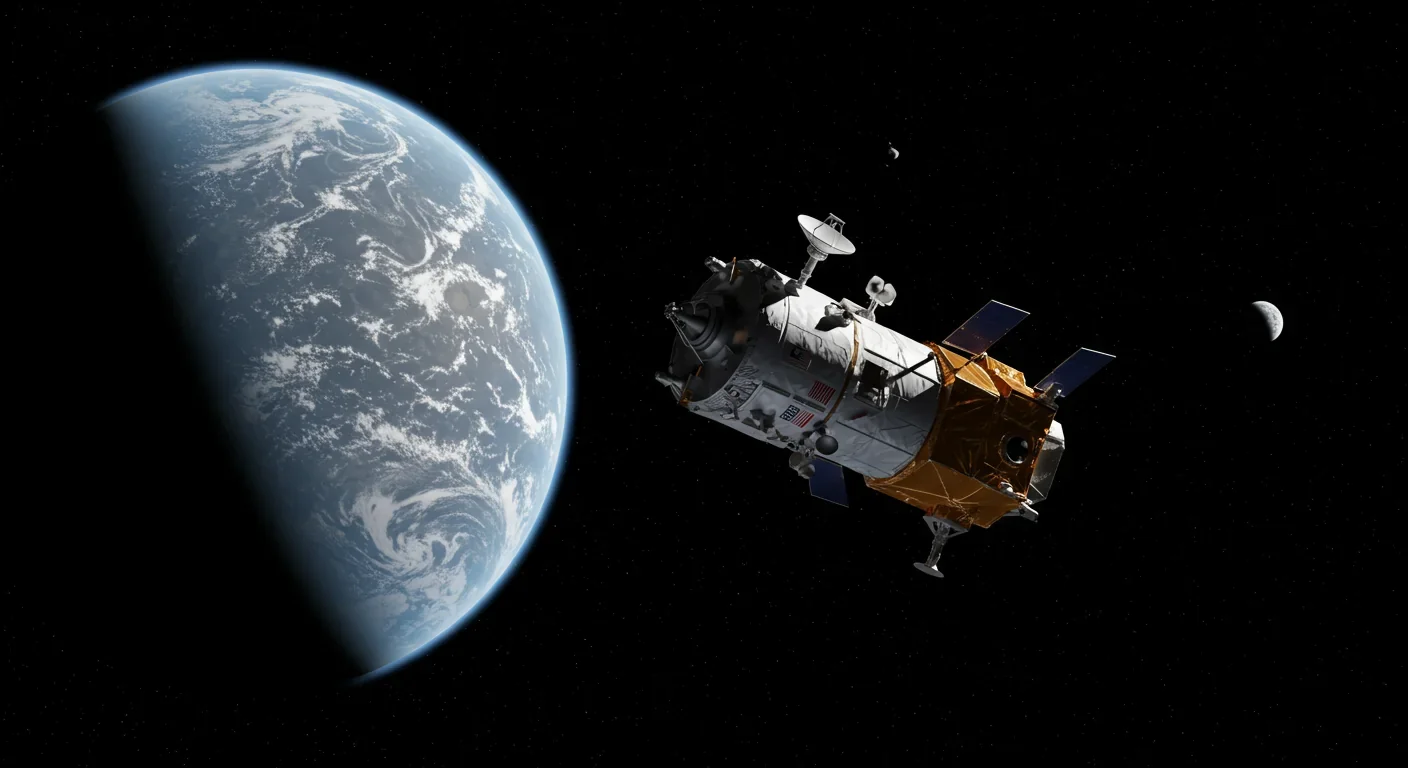
There's one other world in the outer solar system that might offer clues: Triton, Neptune's largest moon. Triton orbits Neptune backward, suggesting it was captured from the Kuiper Belt rather than forming in place. It's similar in size and composition to Pluto, with a thin nitrogen atmosphere and a surface dominated by nitrogen and water ice.
And it's active. Voyager 2's 1989 flyby revealed nitrogen geysers erupting from Triton's surface, visible plumes rising 8 kilometers above the moon. Like Pluto, Triton shows evidence of recent resurfacing.
The key difference? Tidal heating. Triton orbits Neptune in a retrograde path that's slowly decaying. Neptune's gravity continuously kneads Triton's interior, generating friction and heat. Triton has an obvious external heat source.
Pluto doesn't have that advantage. It's locked in a gravitational dance with its large moon Charon, but they're mutually tidally locked, with no tidal flexing to generate heat. Whatever is driving Pluto's activity, it's purely internal. That makes it all the more remarkable.
The existence of nitrogen ice convection on Pluto forces a rethinking of planetary thermal evolution models. There are mechanisms for maintaining geological activity that our models haven't captured. Maybe small icy worlds retain heat more efficiently than we thought. Maybe there are positive feedback loops that can extend a world's geological lifetime by billions of years.
This has profound implications for astrobiology. Life as we know it requires liquid water, energy sources, and organic chemistry. For decades, the hunt for life beyond Earth has focused on Mars and the icy moons of Jupiter and Saturn. Small worlds in the outer solar system were considered biological dead zones.
But if Pluto can maintain a subsurface ocean for billions of years, shielded from space radiation by kilometers of ice, bathed in organic-rich compounds delivered by Kuiper Belt impacts, with chemical energy available from reactions between rock and water... that starts to look like a habitable environment.
"If Pluto formed quickly, it may have started off hot, possibly with a liquid ocean. The rapid accretion would have trapped heat from the colliding bodies, creating an initial thermal reservoir that could persist for billions of years."
— Carver Bierson, Planetary Scientist, UC Santa Cruz
We're not about to find fish swimming under Pluto's ice. But extremophile microorganisms eking out an existence at the ocean-rock interface? That becomes a possibility worth considering. In 2015, such speculation would have been dismissed as science fiction. Now it's a legitimate scientific hypothesis.
New Horizons is long gone, racing out of the solar system at 14 kilometers per second. It flew past Pluto in 2015 and has since encountered Arrokoth, a contact-binary Kuiper Belt object. The spacecraft will never return to Pluto.
But scientists are still analyzing New Horizons data. Every conference brings new papers, new models, new debates about what drives Pluto's unexpected activity. There are proposals for future missions—orbiters that could spend years at Pluto, watching seasonal cycles, tracking changes in the glaciers, even landing to sample the exotic ices directly.
An orbiter could use radar to probe beneath the ice, detecting the subsurface ocean if it exists. A lander could measure heat flow, determining precisely how much energy is escaping from Pluto's interior and where it's coming from. Such missions are technically challenging. It took New Horizons nearly a decade to reach Pluto, and that was a flyby, not an orbiter.
But the scientific payoff would be extraordinary. Imagine watching Pluto's nitrogen ice glaciers in real time over multiple Earth years. Imagine drilling through the ice to sample the ocean below. Imagine deploying seismometers to listen to Pluto's heartbeat.
Understanding Pluto helps us understand planetary processes everywhere, including on Earth. Convection is universal—it drives plate tectonics on Earth, creates Jupiter's banded clouds, shapes Mars's ancient surface features. Every new example of convection in an exotic environment teaches us something about how the process works under different conditions.
The bigger lesson is about assumptions. For decades, planetary scientists assumed small meant simple, distant meant dead. We built our exploration strategies around these assumptions. Pluto proved those assumptions wrong. What other assumptions are we making about the solar system, about exoplanets, about the conditions for habitability that might be equally flawed?
Every time we overturn conventional wisdom, we expand the boundaries of what's possible. Before New Horizons, the outer solar system seemed like a cold, dark, boring place. Now we know it's a frontier of active geology, exotic chemistry, and perhaps even habitable environments.
And there's something deeply human about the Pluto story. Here's a world discovered in 1930 by a young astronomer. A world named by an 11-year-old girl who thought the Roman god of the underworld was a fitting namesake. A world studied for 85 years from Earth-based telescopes that could barely resolve it as more than a dot.
And then, in July 2015, Pluto became real. It transformed from an abstraction into a place. A world with mountains and valleys, glaciers and plains, atmosphere and haze layers. A world that, despite being frozen at temperatures that would shatter steel, is more alive than anyone dared imagine.
That's the power of exploration. Every frontier we cross, every world we visit for the first time, every mystery we unravel reminds us how much we still don't know. Pluto's nitrogen ice glaciers aren't just scientifically important—they're a reminder that the cosmos will always surprise us.
The next generation of scientists studying Pluto aren't even born yet. They'll grow up with high-resolution images of Sputnik Planitia in their textbooks. They'll build on what New Horizons taught us, asking questions we haven't thought to ask yet.
And someday, someone will stand on Pluto's surface for real. They'll watch Charon hanging motionless in the sky, feel the -230°C cold through thick insulation, and know they're standing on an active world at the edge of the solar system. They'll understand viscerally what we're only beginning to grasp intellectually: that geology isn't limited to warm, sunlit worlds. That ice can be as dynamic as rock. That small worlds can harbor deep complexity.
That Pluto, frozen but not dead, has more stories to tell than we ever imagined.

Lunar mass drivers—electromagnetic catapults that launch cargo from the Moon without fuel—could slash space transportation costs from thousands to under $100 per kilogram. This technology would enable affordable space construction, fuel depots, and deep space missions using lunar materials, potentially operational by the 2040s.

Ancient microorganisms called archaea inhabit your gut and perform unique metabolic functions that bacteria cannot, including methane production that enhances nutrient extraction. These primordial partners may influence longevity and offer new therapeutic targets.

CAES stores excess renewable energy by compressing air in underground caverns, then releases it through turbines during peak demand. New advanced adiabatic systems achieve 70%+ efficiency, making this decades-old technology suddenly competitive for long-duration grid storage.

Human children evolved to be raised by multiple caregivers—grandparents, siblings, and community members—not just two parents. Research shows alloparenting reduces parental burnout, improves child development, and is the biological norm across cultures.
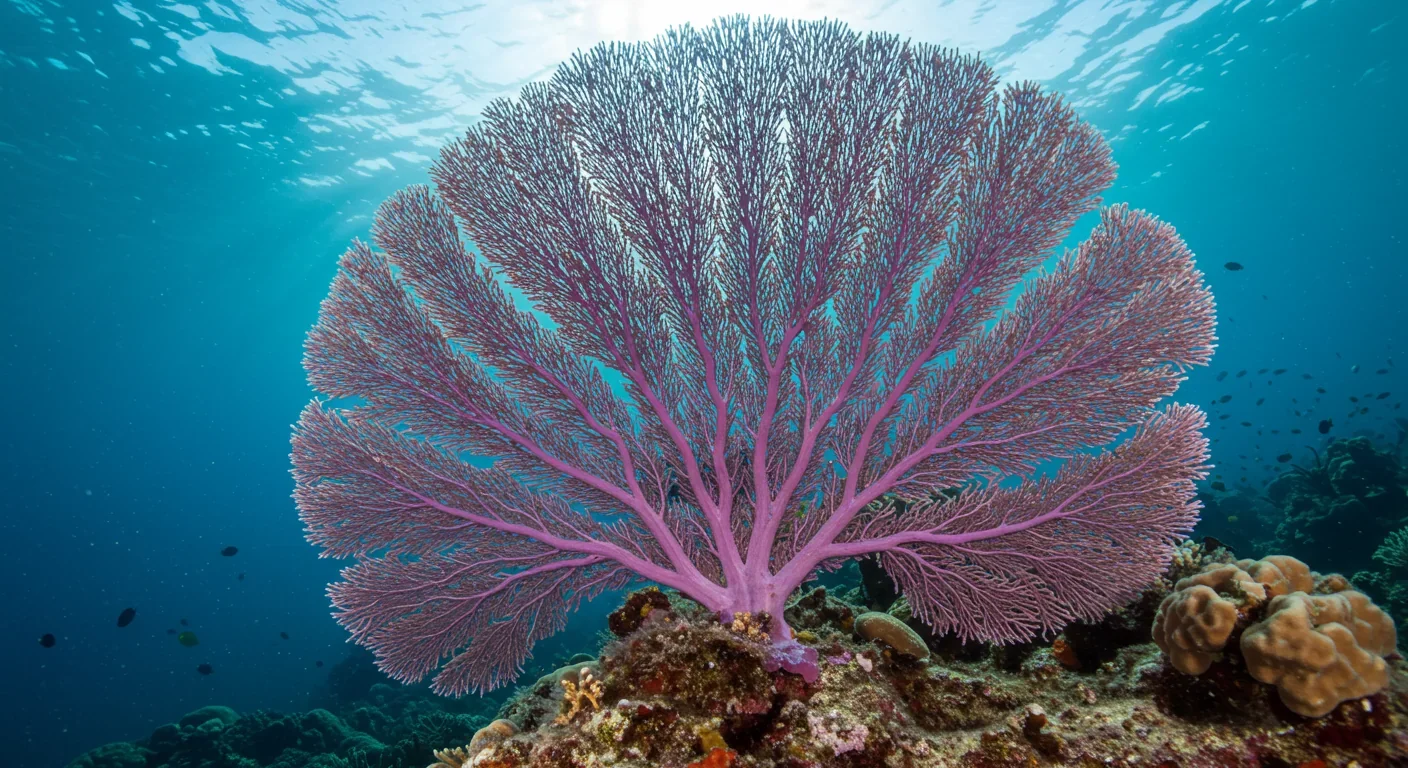
Soft corals have weaponized their symbiotic algae to produce potent chemical defenses, creating compounds with revolutionary pharmaceutical potential while reshaping our understanding of marine ecosystems facing climate change.

Generation Z is the first cohort to come of age amid a polycrisis - interconnected global failures spanning climate, economy, democracy, and health. This cascading reality is fundamentally reshaping how young people think, plan their lives, and organize for change.

Zero-trust security eliminates implicit network trust by requiring continuous verification of every access request. Organizations are rapidly adopting this architecture to address cloud computing, remote work, and sophisticated threats that rendered perimeter defenses obsolete.